RENAULT CLIO SPORT TOURER 2012 X85 / 3.G Service Manual
Manufacturer: RENAULT, Model Year: 2012, Model line: CLIO SPORT TOURER, Model: RENAULT CLIO SPORT TOURER 2012 X85 / 3.GPages: 264, PDF Size: 7.7 MB
Page 41 of 264
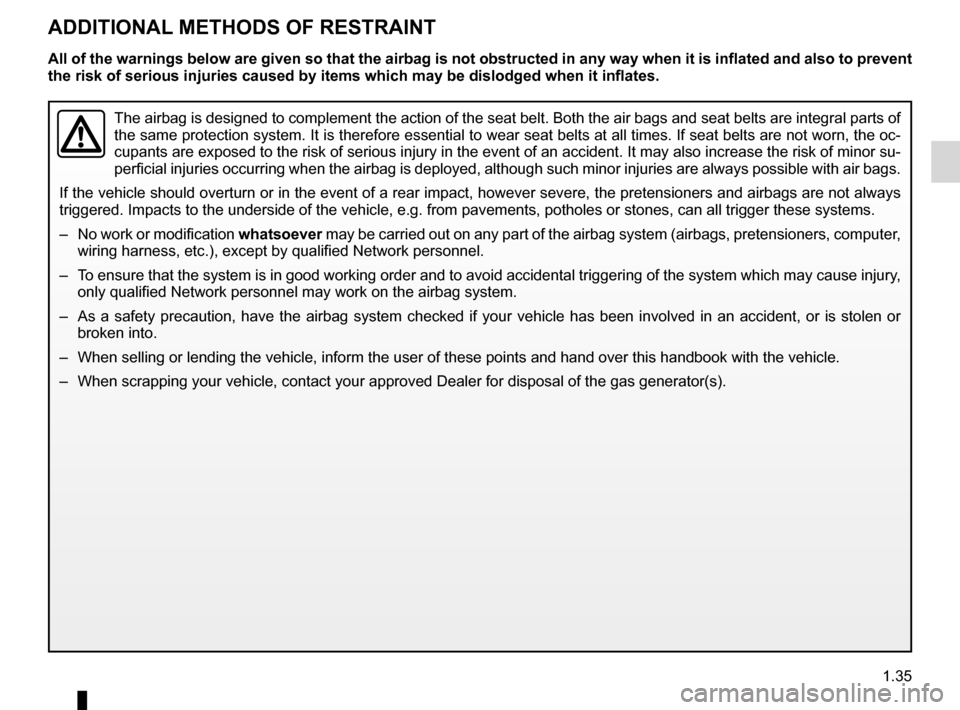
additional methods of restraint ............. (up to the end of the DU)
methods of restraint in addition to the seat belts
(up to the end of the DU)
air bag ................................................... (up to the end of the DU)
air bag ................................................... (up to the end of the DU)
1.35
ENG_UD19772_2
Dispositifs de retenue complémentaire (X85 - B85 - C85 - S85 - K85 -\
Renault)
ENG_NU_853-8_BCSK85_Renault_1
ADDITIONAL METHODS OF RESTRAINT
The airbag is designed to complement the action of the seat belt. Both the air bags and seat belts are integral parts of
the same protection system. It is therefore essential to wear seat belts at all times. If seat belts are not worn, the oc-
cupants are exposed to the risk of serious injury in the event of an accident. It may also increase the risk of minor su-
perficial injuries occurring when the airbag is deployed, although such minor injuries are always possible with air bags.
If the vehicle should overturn or in the event of a rear impact, however severe, the pretensioners and airbags are not always
triggered. Impacts to the underside of the vehicle, e.g. from pavements,\
potholes or stones, can all trigger these systems.
– No work or modification whatsoever may be carried out on any part of the airbag system (airbags, pretensioners, computer,
wiring harness, etc.), except by qualified Network personnel.
– To ensure that the system is in good working order and to avoid accidental triggering of the system which may cause injury,
only qualified Network personnel may work on the airbag system.
– As a safety precaution, have the airbag system checked if your vehicle has been involved in an accident, or is stolen or
broken into.
– When selling or lending the vehicle, inform the user of these points and hand over this handbook with the vehicle.
– When scrapping your vehicle, contact your approved Dealer for disposal of the gas generator(s).
All of the warnings below are given so that the airbag is not obstructed in any way when it is inflated and also to prevent
the risk of serious injuries caused by items which may be dislodged when\
it inflates.
Page 42 of 264
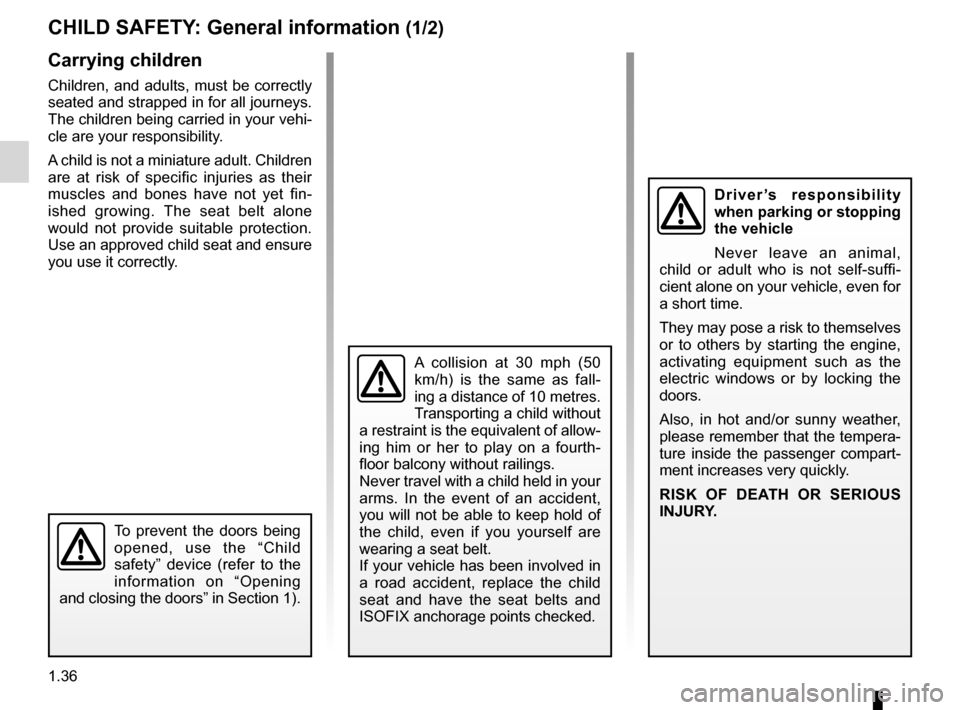
child safety............................................ (up to the end of the DU)
child restraint/seat ................................ (up to the end of the DU)
child restraint/seat ................................ (up to the end of the DU)
child restraint/seat ................................ (up to the end of the DU)
child seats ............................................. (up to the end of the DU)
transporting children ............................. (up to the end of the DU)
children ................................................. (up to the end of the DU)
1.36
ENG_UD18356_1
Sécurité enfants : généralités (X45 - H45 - L38 - X38 - \
X32 - Renault)
ENG_NU_853-8_BCSK85_Renault_1
Jaune NoirNoir texte
Child safety: General information
CHILD SAFETY : General information (1/2)
Carrying children
Children, and adults, must be correctly
seated and strapped in for all journeys.
The children being carried in your vehi-
cle are your responsibility.
A child is not a miniature adult. Children
are at risk of specific injuries as their
muscles and bones have not yet fin -
ished growing. The seat belt alone
would not provide suitable protection.
Use an approved child seat and ensure
you use it correctly.
A collision at 30 mph (50
km/h) is the same as fall -
ing a distance of 10 metres.
Transporting a child without
a restraint is the equivalent of allow -
ing him or her to play on a fourth -
floor balcony without railings.
Never travel with a child held in your
arms. In the event of an accident,
you will not be able to keep hold of
the child, even if you yourself are
wearing a seat belt.
If your vehicle has been involved in
a road accident, replace the child
seat and have the seat belts and
ISOFIX anchorage points checked.
To prevent the doors being
opened, use the “Child
safety” device (refer to the
information on “Opening
and closing the doors” in Section 1).
D r i v e r ’s r e s p o n s i b i l i t y
when parking or stopping
the vehicle
Never leave an animal,
child or adult who is not self-suffi -
cient alone on your vehicle, even for
a short time.
They may pose a risk to themselves
or to others by starting the engine,
activating equipment such as the
electric windows or by locking the
doors.
Also, in hot and/or sunny weather,
please remember that the tempera-
ture inside the passenger compart-
ment increases very quickly.
RISK OF DEATH OR SERIOUS
INJURY.
Page 43 of 264
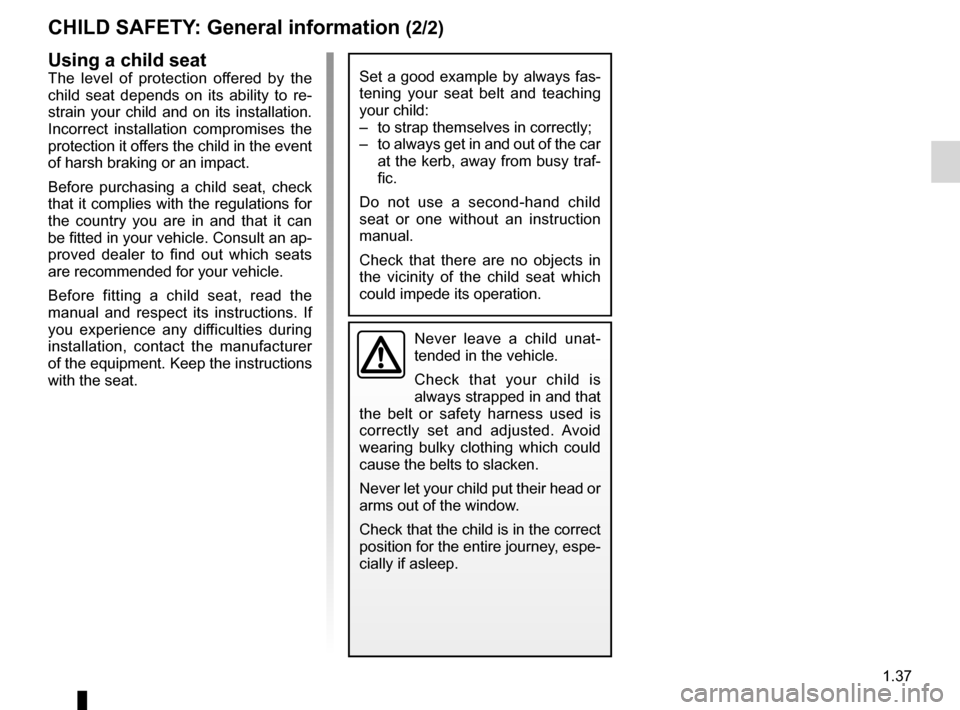
child safety............................................ (up to the end of the DU)
child restraint/seat ................................ (up to the end of the DU)
child restraint/seat ................................ (up to the end of the DU)
child restraint/seat ................................ (up to the end of the DU)
child seats ............................................. (up to the end of the DU)
transporting children ............................. (up to the end of the DU)
children ................................................. (up to the end of the DU)
JauneNoirNoir texte
1.37
ENG_UD18356_1
Sécurité enfants : généralités (X45 - H45 - L38 - X38 - \
X32 - Renault)
ENG_NU_853-8_BCSK85_Renault_1
CHILD SAFETY : General information (2/2)
Using a child seat
The level of protection offered by the
child seat depends on its ability to re -
strain your child and on its installation.
Incorrect installation compromises the
protection it offers the child in the event
of harsh braking or an impact.
Before purchasing a child seat, check
that it complies with the regulations for
the country you are in and that it can
be fitted in your vehicle. Consult an ap-
proved dealer to find out which seats
are recommended for your vehicle.
Before fitting a child seat, read the
manual and respect its instructions. If
you experience any difficulties during
installation, contact the manufacturer
of the equipment. Keep the instructions
with the seat.Set a good example by always fas-
tening your seat belt and teaching
your child:
– to strap themselves in correctly;
– to always get in and out of the car
at the kerb, away from busy traf-
fic.
Do not use a second-hand child
seat or one without an instruction
manual.
Check that there are no objects in
the vicinity of the child seat which
could impede its operation.
Never leave a child unat -
tended in the vehicle.
Check that your child is
always strapped in and that
the belt or safety harness used is
correctly set and adjusted. Avoid
wearing bulky clothing which could
cause the belts to slacken.
Never let your child put their head or
arms out of the window.
Check that the child is in the correct
position for the entire journey, espe-
cially if asleep.
Page 44 of 264
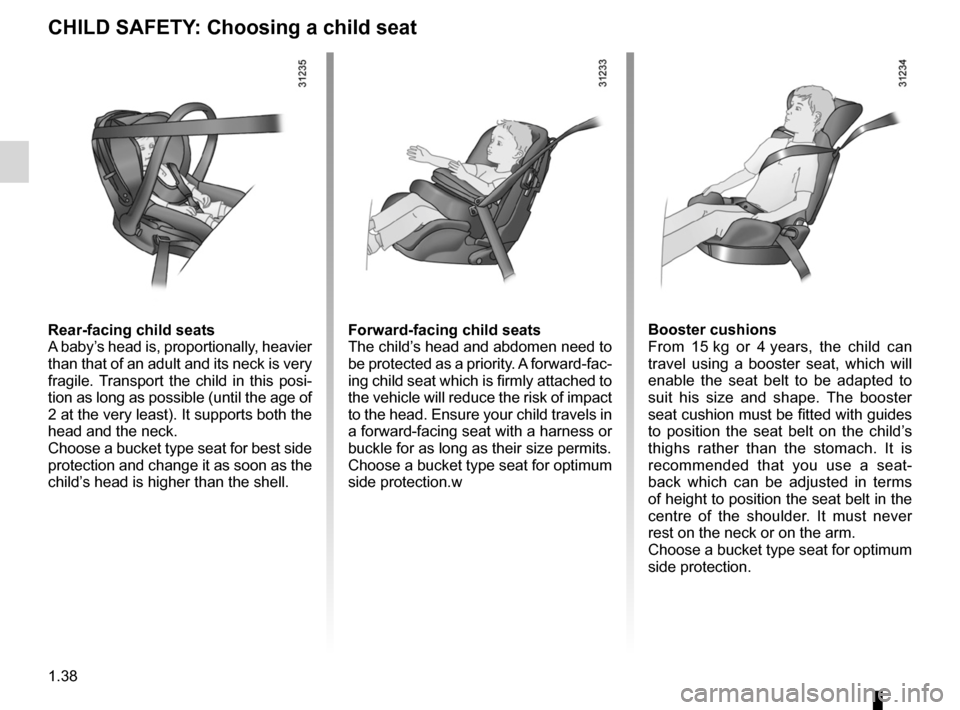
1.38
ENG_UD18759_2
Sécurité enfants : choix du siège enfant (X35 - L35 - X45 - H4\
5 - X77 - X91 - X83 - X61 - X77 ph2 - X95 - L38 - X38 - X62 - Renault)
ENG_NU_853-8_BCSK85_Renault_1
CHILD SAFETY : Choosing a child seat
Rear-facing child seats
A baby’s head is, proportionally, heavier
than that of an adult and its neck is very
fragile. Transport the child in this posi-
tion as long as possible (until the age of
2 at the very least). It supports both the
head and the neck.
Choose a bucket type seat for best side
protection and change it as soon as the
child’s head is higher than the shell.Forward-facing child seats
The child’s head and abdomen need to
be protected as a priority. A forward-fac-
ing child seat which is firmly attached to
the vehicle will reduce the risk of impact
to the head. Ensure your child travels in
a forward-facing seat with a harness or
buckle for as long as their size permits.
Choose a bucket type seat for optimum
side protection.w Booster cushions
From 15
kg or 4 years, the child can
travel using a booster seat, which will
enable the seat belt to be adapted to
suit his size and shape. The booster
seat cushion must be fitted with guides
to position the seat belt on the child’s
thighs rather than the stomach. It is
recommended that you use a seat -
back which can be adjusted in terms
of height to position the seat belt in the
centre of the shoulder. It must never
rest on the neck or on the arm.
Choose a bucket type seat for optimum
side protection.
Page 45 of 264
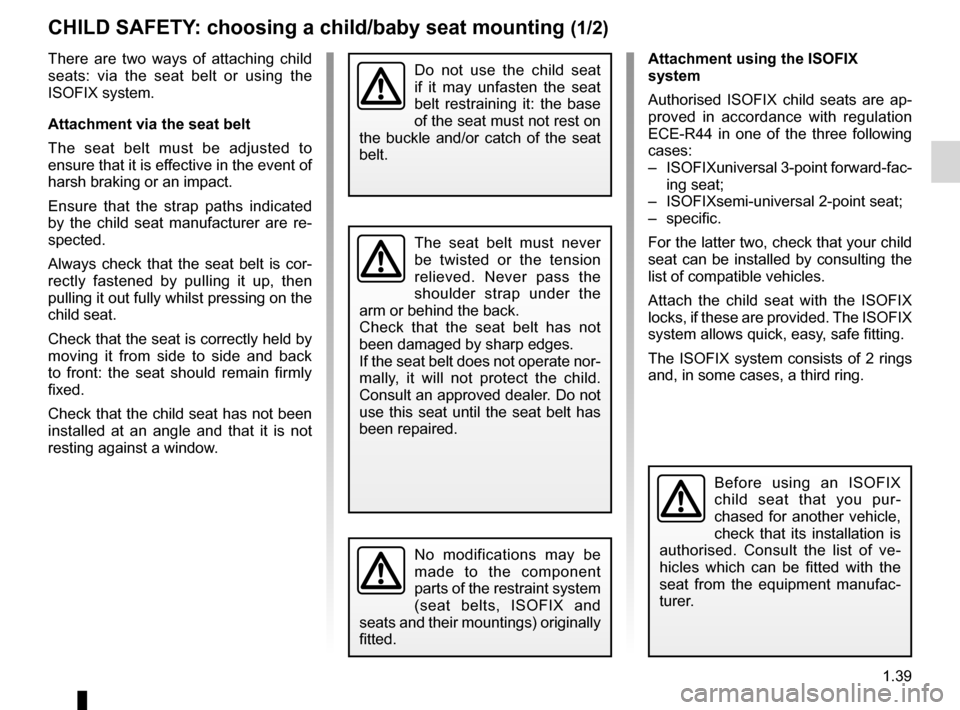
child restraint/seat ................................ (up to the end of the DU)
child restraint/seat ................................ (up to the end of the DU)
child restraint/seat ................................ (up to the end of the DU)
child safety ............................................ (up to the end of the DU)
child seats ............................................. (up to the end of the DU)
transporting children ............................. (up to the end of the DU)
Isofix ..................................................... (up to the end of the DU)
1.39
ENG_UD22283_2
Sécurité enfants : choix de la fixation du siège enfant (X85 -\
B85 - C85 - S85 - K85 - Renault)
ENG_NU_853-8_BCSK85_Renault_1
Choosing a child seat mounting
CHILD SAFETY : choosing a child/baby seat mounting (1/2)
There are two ways of attaching child
seats: via the seat belt or using the
ISOFIX system.
Attachment via the seat belt
The seat belt must be adjusted to
ensure that it is effective in the event of
harsh braking or an impact.
Ensure that the strap paths indicated
by the child seat manufacturer are re-
spected.
Always check that the seat belt is cor-
rectly fastened by pulling it up, then
pulling it out fully whilst pressing on the
child seat.
Check that the seat is correctly held by
moving it from side to side and back
to front: the seat should remain firmly
fixed.
Check that the child seat has not been
installed at an angle and that it is not
resting against a window.Do not use the child seat
if it may unfasten the seat
belt restraining it: the base
of the seat must not rest on
the buckle and/or catch of the seat
belt.
The seat belt must never
be twisted or the tension
relieved. Never pass the
shoulder strap under the
arm or behind the back.
Check that the seat belt has not
been damaged by sharp edges.
If the seat belt does not operate nor-
mally, it will not protect the child.
Consult an approved dealer. Do not
use this seat until the seat belt has
been repaired.
No modifications may be
made to the component
parts of the restraint system
(seat belts, ISOFIX and
seats and their mountings) originally
fitted.
Attachment using the ISOFIX
system
Authorised ISOFIX child seats are ap -
proved in accordance with regulation
ECE-R44 in one of the three following
cases:
– ISOFIXuniversal 3-point forward-fac-
ing seat;
– ISOFIXsemi-universal 2-point seat;
– specific.
For the latter two, check that your child
seat can be installed by consulting the
list of compatible vehicles.
Attach the child seat with the ISOFIX
locks, if these are provided. The ISOFIX
system allows quick, easy, safe fitting.
The ISOFIX system consists of 2 rings
and, in some cases, a third ring.
Before using an ISOFIX
child seat that you pur -
chased for another vehicle,
check that its installation is
authorised. Consult the list of ve -
hicles which can be fitted with the
seat from the equipment manufac -
turer.
Page 46 of 264
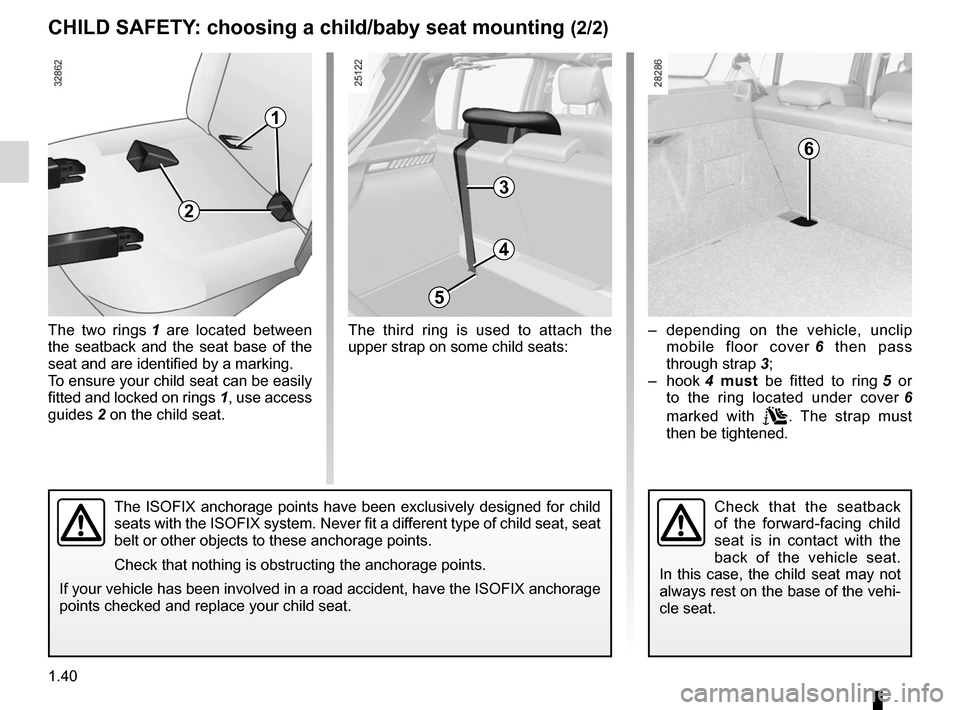
1.40
ENG_UD22283_2
Sécurité enfants : choix de la fixation du siège enfant (X85 -\
B85 - C85 - S85 - K85 - Renault)
ENG_NU_853-8_BCSK85_Renault_1
CHILD SAFETY : choosing a child/baby seat mounting (2/2)
The two rings 1 are located between
the seatback and the seat base of the
seat and are identified by a marking.
To ensure your child seat can be easily
fitted and locked on rings 1, use access
guides 2 on the child seat.
The ISOFIX anchorage points have been exclusively designed for child
seats with the ISOFIX system. Never fit a different type of child seat, seat
belt or other objects to these anchorage points.
Check that nothing is obstructing the anchorage points.
If your vehicle has been involved in a road accident, have the ISOFIX anchorage
points checked and replace your child seat.
The third ring is used to attach the
upper strap on some child seats:
3
4
5
– depending on the vehicle, unclip
mobile floor cover 6 then pass
through strap 3;
– hook 4 must be fitted to ring 5 or
to the ring located under cover 6
marked with
. The strap must
then be tightened.
6
Check that the seatback
of the forward-facing child
seat is in contact with the
back of the vehicle seat.
In this case, the child seat may not
always rest on the base of the vehi-
cle seat.
1
2
Page 47 of 264
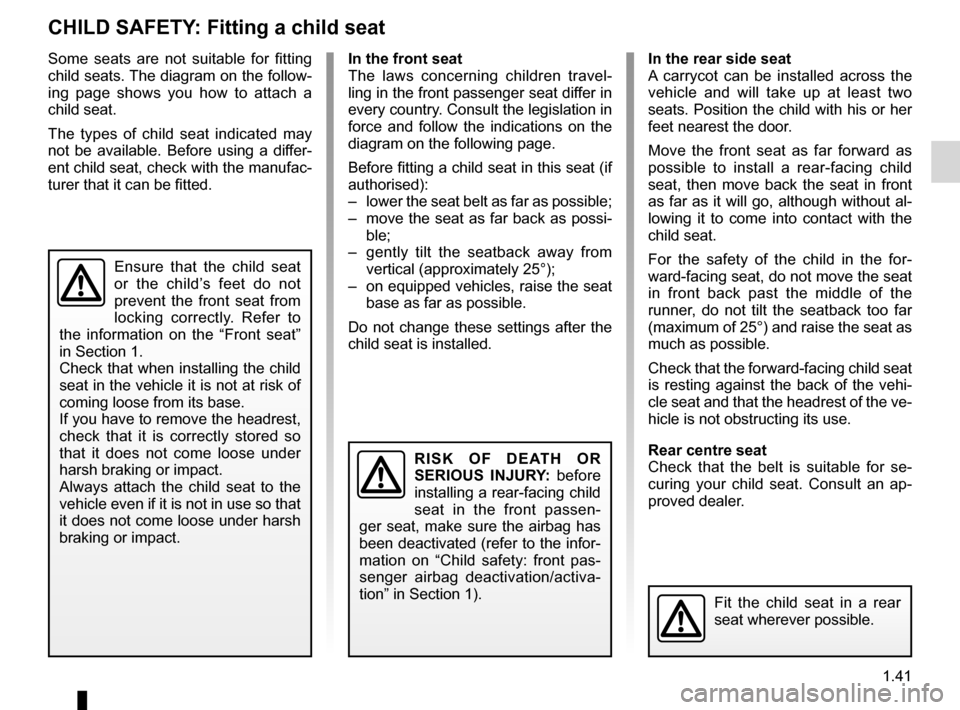
child restraint/seat ................................ (up to the end of the DU)
child restraint/seat ................................ (up to the end of the DU)
child restraint/seat ................................ (up to the end of the DU)
child safety ............................................ (up to the end of the DU)
child seats ............................................. (up to the end of the DU)
transporting children ............................. (up to the end of the DU)
1.41
ENG_UD24917_5
Sécurité enfants : installation du siège enfant (X85 - B85 - C\
85 - S85 - K85 - Renault)
ENG_NU_853-8_BCSK85_Renault_1
Fitting a child seat
CHILD SAFETY : Fitting a child seat
Some seats are not suitable for fitting
child seats. The diagram on the follow -
ing page shows you how to attach a
child seat.
The types of child seat indicated may
not be available. Before using a differ-
ent child seat, check with the manufac-
turer that it can be fitted.
Ensure that the child seat
or the child’s feet do not
prevent the front seat from
locking correctly. Refer to
the information on the “Front seat”
in Section 1.
Check that when installing the child
seat in the vehicle it is not at risk of
coming loose from its base.
If you have to remove the headrest,
check that it is correctly stored so
that it does not come loose under
harsh braking or impact.
Always attach the child seat to the
vehicle even if it is not in use so that
it does not come loose under harsh
braking or impact.
In the front seat
The laws concerning children travel -
ling in the front passenger seat differ in
every country. Consult the legislation in
force and follow the indications on the
diagram on the following page.
Before fitting a child seat in this seat (if
authorised):
– lower the seat belt as far as possible;
– move the seat as far back as possi-
ble;
– gently tilt the seatback away from
vertical (approximately 25°);
– on equipped vehicles, raise the seat
base as far as possible.
Do not change these settings after the
child seat is installed. In the rear side seat
A carrycot can be installed across the
vehicle and will take up at least two
seats. Position the child with his or her
feet nearest the door.
Move the front seat as far forward as
possible to install a rear-facing child
seat, then move back the seat in front
as far as it will go, although without al-
lowing it to come into contact with the
child seat.
For the safety of the child in the for
-
ward-facing seat, do not move the seat
in front back past the middle of the
runner, do not tilt the seatback too far
(maximum of 25°) and raise the seat as
much as possible.
Check that the forward-facing child seat
is resting against the back of the vehi-
cle seat and that the headrest of the ve-
hicle is not obstructing its use.
Rear centre seat
Check that the belt is suitable for se -
curing your child seat. Consult an ap -
proved dealer.
R I S K O F D E AT H O R
SERIOUS INJURY: before
installing a rear-facing child
seat in the front passen -
ger seat, make sure the airbag has
been deactivated (refer to the infor-
mation on “Child safety: front pas -
senger airbag deactivation/activa -
tion” in Section 1).
Fit the child seat in a rear
seat wherever possible.
Page 48 of 264
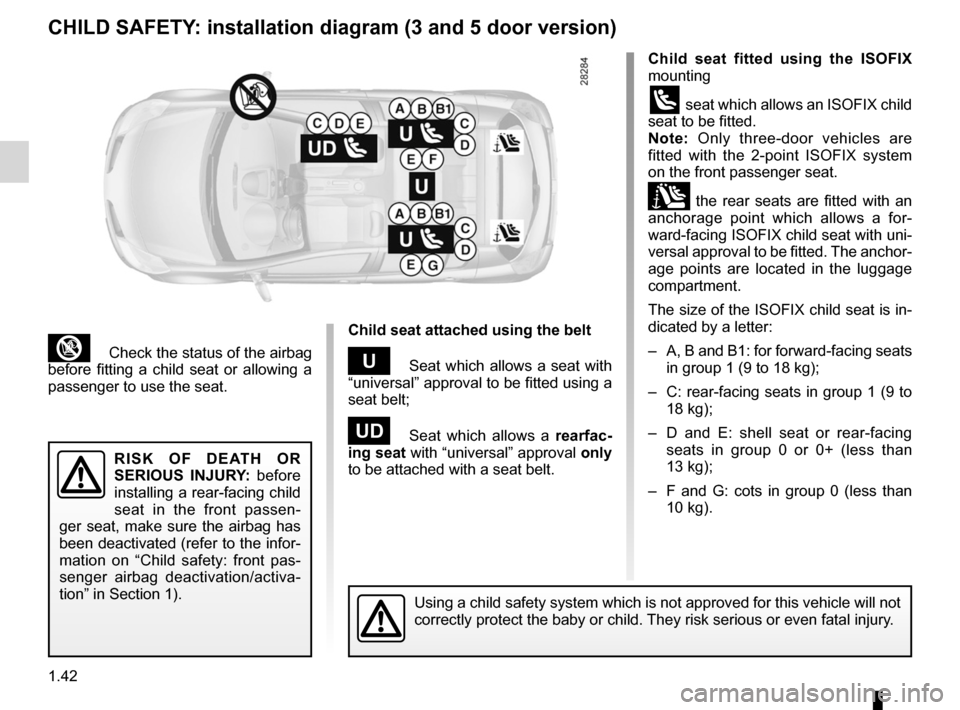
1.42
ENG_UD24917_5
Sécurité enfants : installation du siège enfant (X85 - B85 - C\
85 - S85 - K85 - Renault)
ENG_NU_853-8_BCSK85_Renault_1
Jaune NoirNoir texte
³ Check the status of the airbag
before fitting a child seat or allowing a
passenger to use the seat.
CHILD SAFETY : installation diagram (3 and 5 door version)
Child seat fitted using the ISOFIX
mounting
ü seat which allows an ISOFIX child
seat to be fitted.
Note: Only three-door vehicles are
fitted with the 2-point ISOFIX system
on the front passenger seat.
± the rear seats are fitted with an
anchorage point which allows a for -
ward-facing ISOFIX child seat with uni-
versal approval to be fitted. The anchor-
age points are located in the luggage
compartment.
The size of the ISOFIX child seat is in-
dicated by a letter:
– A, B and B1: for forward-facing seats
in group 1 (9 to 18 kg);
– C: rear-facing seats in group 1 (9 to
18 kg);
– D and E: shell seat or rear-facing
seats in group 0 or 0+ (less than
13 kg);
– F and G: cots in group 0 (less than
10 kg).
Child seat attached using the belt
¬
Seat which allows a seat with
“universal” approval to be fitted using a
seat belt;
− Seat which allows a rearfac-
ing seat with “universal” approval only
to be attached with a seat belt.
Using a child safety system which is not approved for this vehicle will not
correctly protect the baby or child. They risk serious or even fatal injury.
R I S K O F D E AT H O R
SERIOUS INJURY: before
installing a rear-facing child
seat in the front passen -
ger seat, make sure the airbag has
been deactivated (refer to the infor-
mation on “Child safety: front pas -
senger airbag deactivation/activa -
tion” in Section 1).
Page 49 of 264
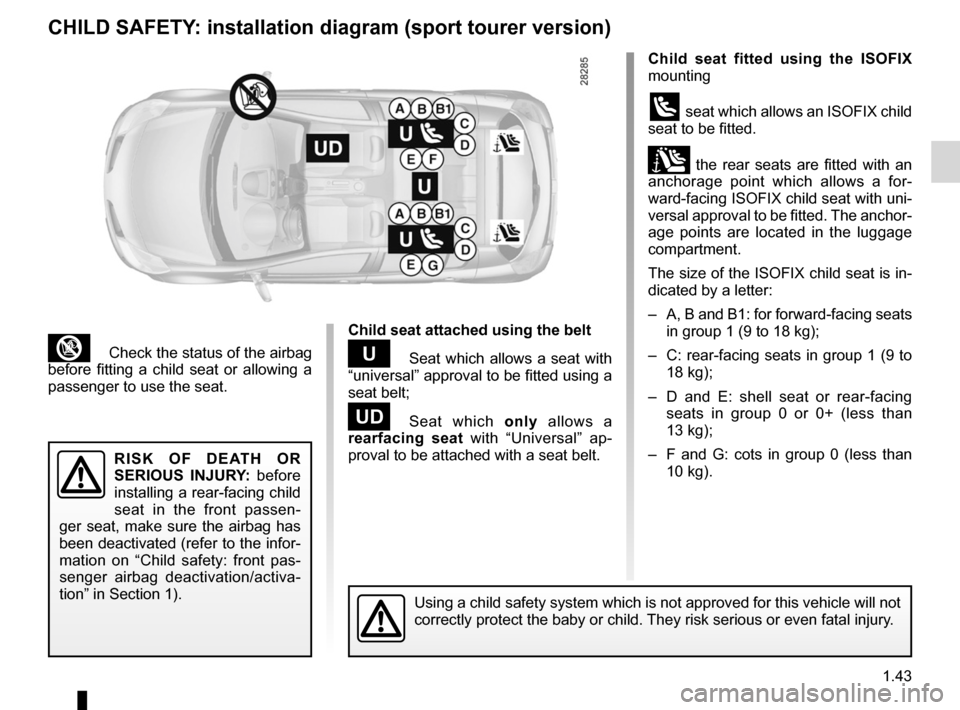
JauneNoirNoir texte
1.43
ENG_UD24917_5
Sécurité enfants : installation du siège enfant (X85 - B85 - C\
85 - S85 - K85 - Renault)
ENG_NU_853-8_BCSK85_Renault_1
³ Check the status of the airbag
before fitting a child seat or allowing a
passenger to use the seat.
CHILD SAFETY : installation diagram (sport tourer version)
Child seat fitted using the ISOFIX
mounting
ü seat which allows an ISOFIX child
seat to be fitted.
± the rear seats are fitted with an
anchorage point which allows a for -
ward-facing ISOFIX child seat with uni-
versal approval to be fitted. The anchor-
age points are located in the luggage
compartment.
The size of the ISOFIX child seat is in-
dicated by a letter:
– A, B and B1: for forward-facing seats
in group 1 (9 to 18 kg);
– C: rear-facing seats in group 1 (9 to
18 kg);
– D and E: shell seat or rear-facing
seats in group 0 or 0+ (less than
13 kg);
– F and G: cots in group 0 (less than
10 kg).
Child seat attached using the belt
¬
Seat which allows a seat with
“universal” approval to be fitted using a
seat belt;
− Seat which only allows a
rearfacing seat with “Universal” ap -
proval to be attached with a seat belt.
Using a child safety system which is not approved for this vehicle will not
correctly protect the baby or child. They risk serious or even fatal injury.
R I S K O F D E AT H O R
SERIOUS INJURY: before
installing a rear-facing child
seat in the front passen -
ger seat, make sure the airbag has
been deactivated (refer to the infor-
mation on “Child safety: front pas -
senger airbag deactivation/activa -
tion” in Section 1).
Page 50 of 264
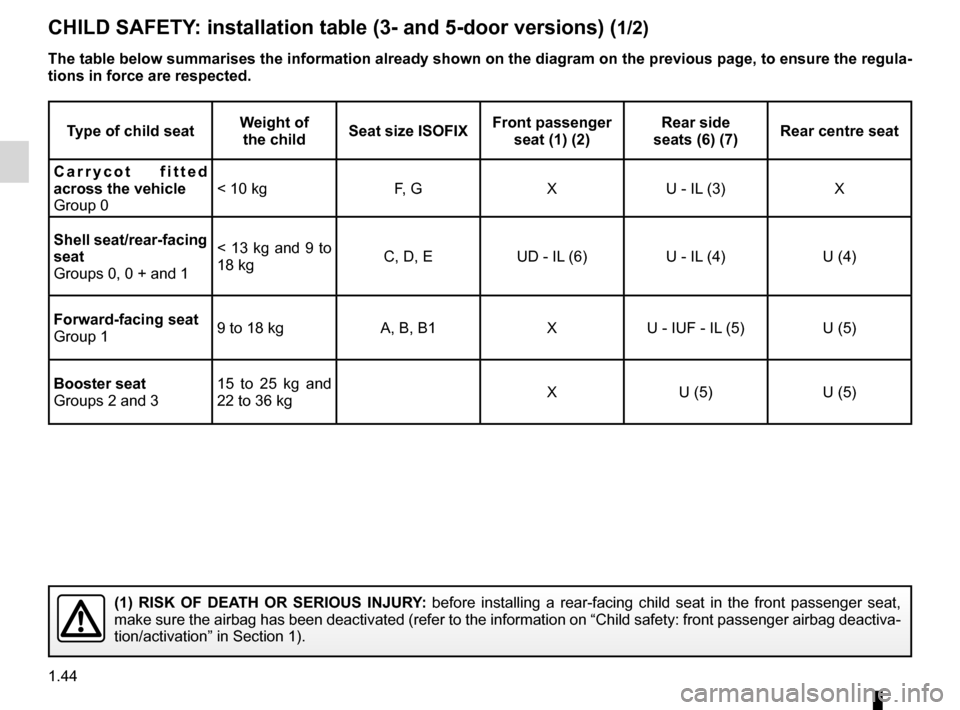
1.44
ENG_UD24917_5
Sécurité enfants : installation du siège enfant (X85 - B85 - C\
85 - S85 - K85 - Renault)
ENG_NU_853-8_BCSK85_Renault_1
Jaune NoirNoir texte
CHILD SAFETY : installation table (3- and 5-door versions) (1/2)
(1) RISK OF DEATH OR SERIOUS INJURY: before installing a rear-facing child seat in the front passenger seat,
make sure the airbag has been deactivated (refer to the information on “Child safety: front passenger airbag deactiva -
tion/activation” in Section 1).
Type of child seat Weight of
the child Seat size ISOFIX Front passenger
seat (1) (2) Rear side
seats (6) (7) Rear centre seat
C a r r y c o t f i t t e d
across the vehicle
Group 0 < 10 kg
F, GXU - IL (3) X
Shell seat/rear-facing
seat
Groups 0, 0 + and 1 < 13 kg and 9 to
18 kg
C, D, E
UD - IL (6) U - IL (4) U (4)
Forward-facing seat
Group 1 9 to 18 kg
A, B, B1 XU - IUF - IL (5) U (5)
Booster seat
Groups 2 and 3 15 to 25 kg and
22 to 36 kg
X
U (5) U (5)
The table below summarises the information already shown on the diagram on the previous page, to ensure the regula-
tions in force are respected.